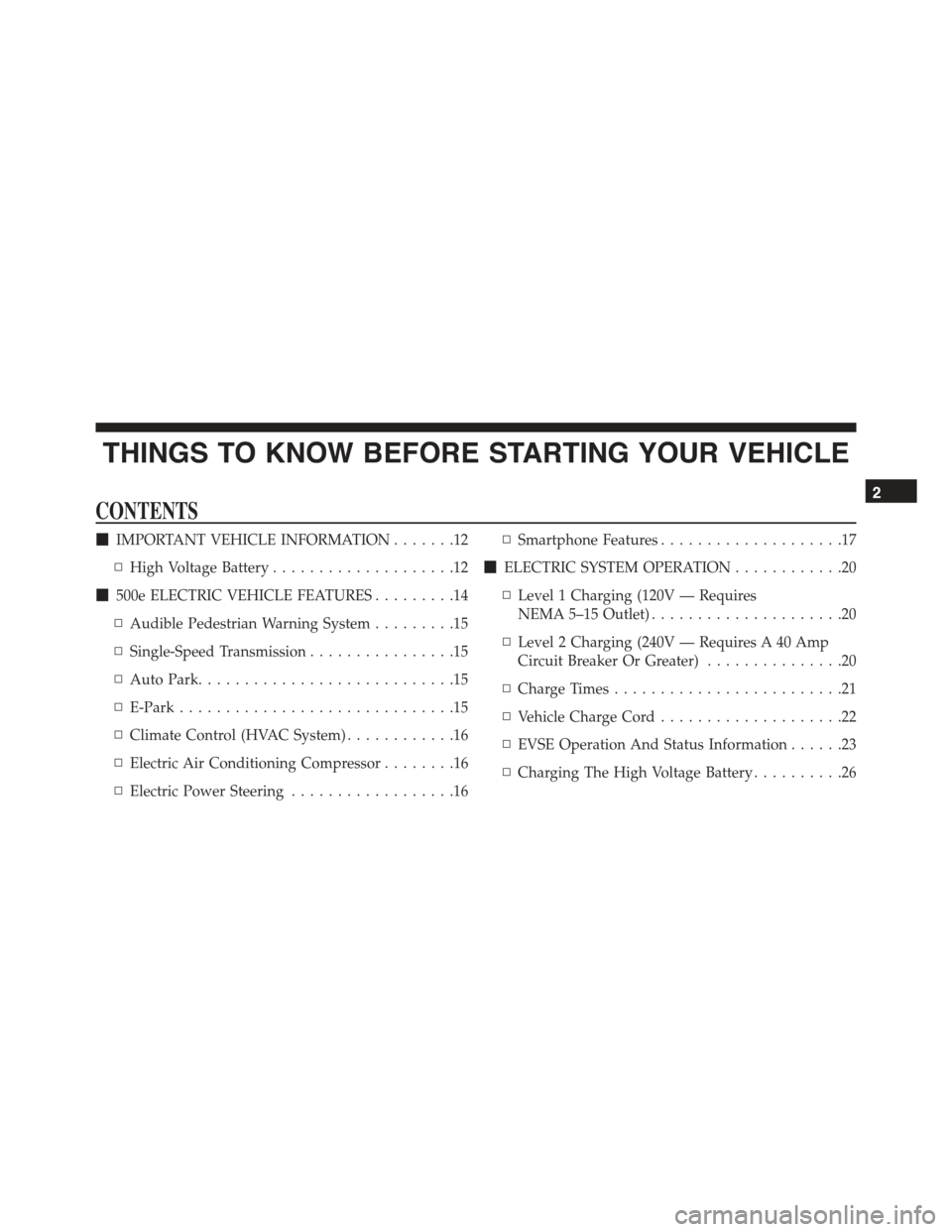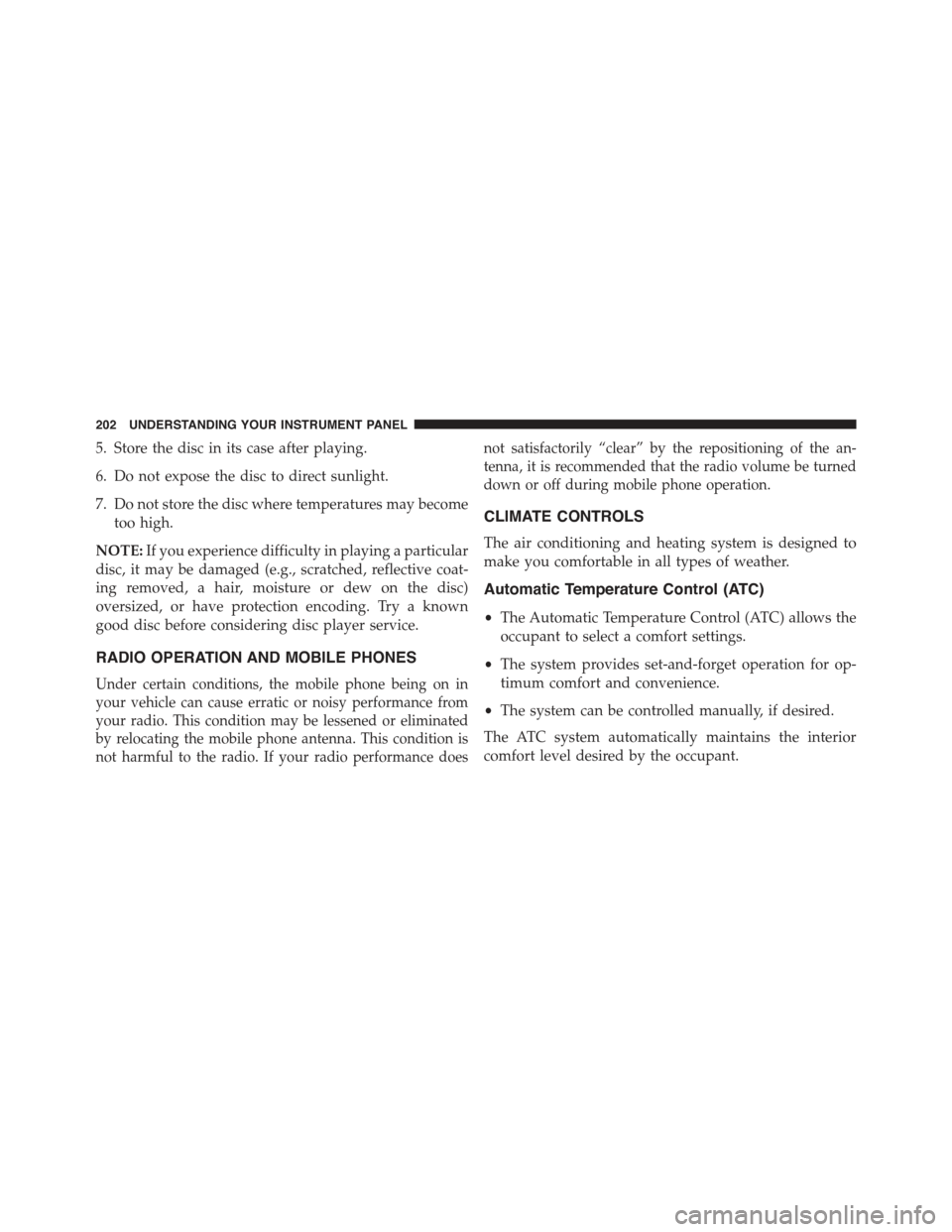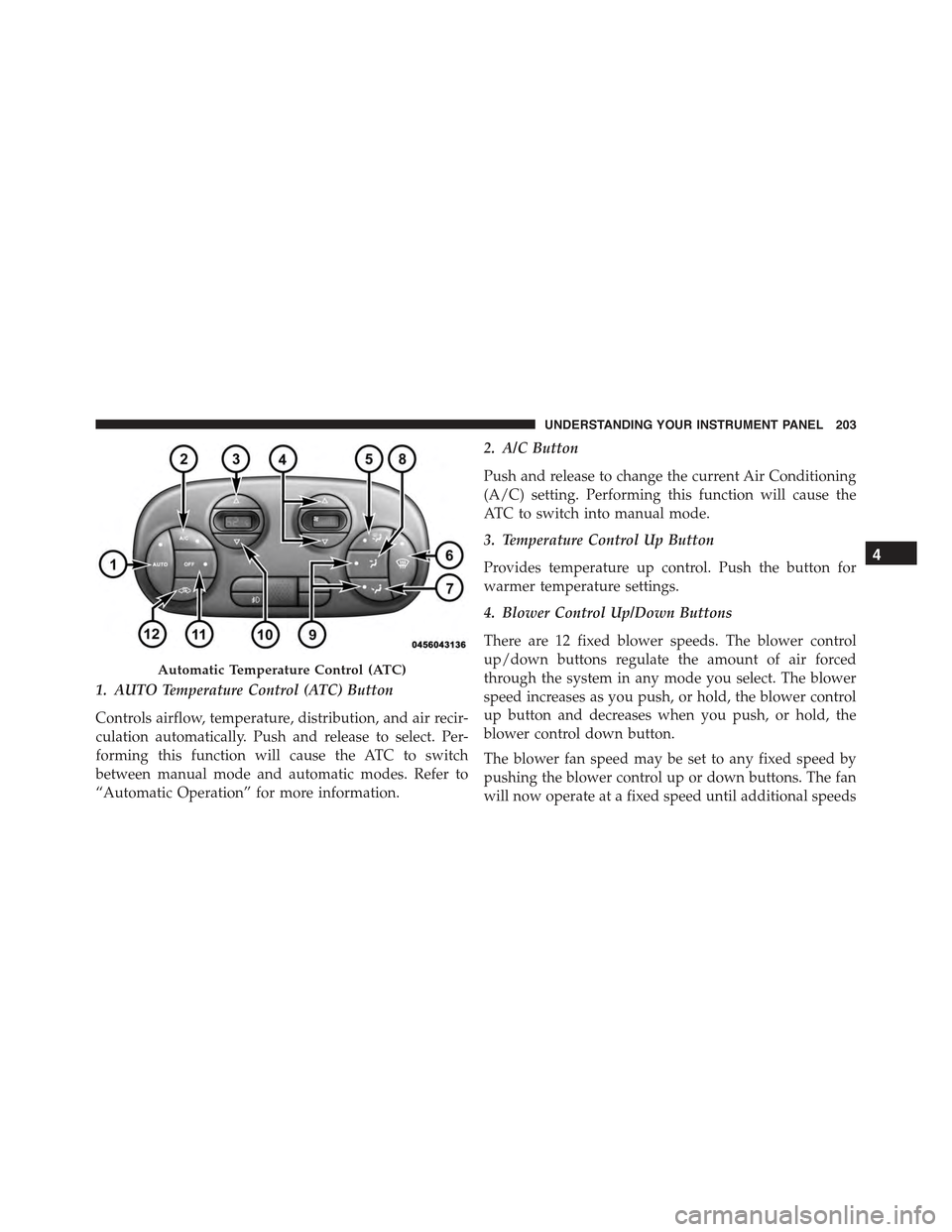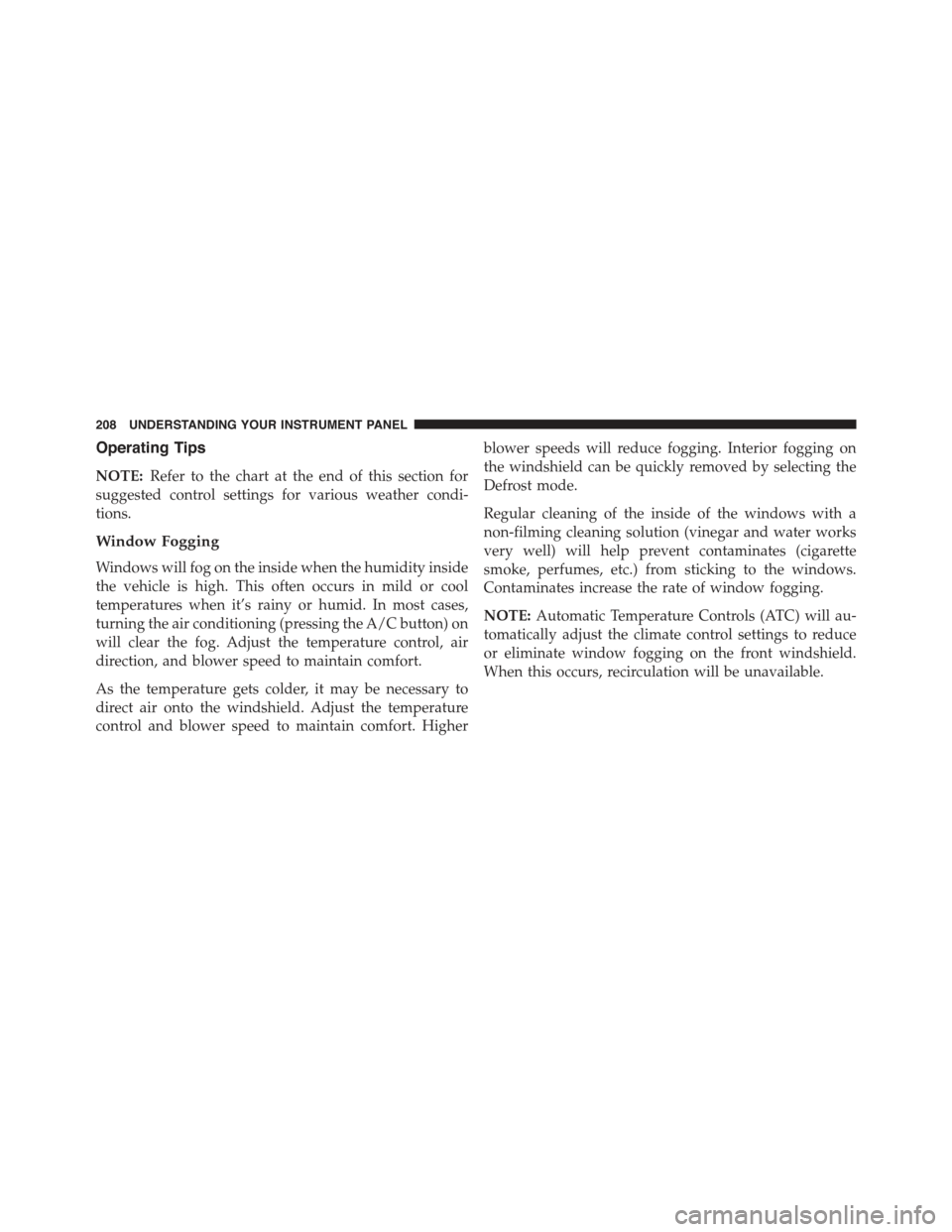2015 FIAT 500E air conditioning
[x] Cancel search: air conditioningPage 11 of 367

THINGS TO KNOW BEFORE STARTING YOUR VEHICLE
CONTENTS
!IMPORTANT VEHICLE INFORMATION.......12
▫High Voltage Battery....................12
!500e ELECTRIC VEHICLE FEATURES.........14
▫Audible Pedestrian Warning System.........15
▫Single-Speed Transmission................15
▫Auto Park............................15
▫E-Park..............................15
▫Climate Control (HVAC System)............16
▫Electric Air Conditioning Compressor........16
▫Electric Power Steering..................16
▫Smartphone Features....................17
!ELECTRIC SYSTEM OPERATION............20
▫Level 1 Charging (120V — Requires
NEMA 5–15 Outlet).....................20
▫Level 2 Charging (240V — Requires A 40 Amp
Circuit Breaker Or Greater)...............20
▫Charge Times.........................21
▫Vehicle Charge Cord....................22
▫EVSE Operation And Status Information......23
▫Charging The High Voltage Battery..........26
2
Page 18 of 367

E-Park is activated when the driver pushes the PARK
button. An electric motor activates the parking pawl and
locks the single-speed transmission when the vehicle is
placed into PARK. This will prevent any unwanted
movement of the vehicle.
NOTE:The engagement of the E-Park can be heard when
there is no noise in the interior of the vehicle, this is a
normal condition.
Climate Control (HVAC System)
Your 500e is equipped with an Automatic Temperature
Control (ATC) HVAC system. This HVAC system utilizes
a humidity sensor, cabin sensor, and ambient tempera-
ture sensor to choose operation mode and control cabin
comfort. These components allow the controller to oper-
ate the HVAC system in a very efficient manner to
maximize driving range.
Your 500e also uses an electric air heater to provide heat
to the cabin.
Electric Air Conditioning Compressor
Your 500e uses an electric air conditioning compressor.
The air conditioning compressor is powered by the high
voltage battery system and is used to cool the vehicle
occupants and the high voltage battery while the vehicle
is being driven or when it is being charged.
The high voltage battery may require cooling to keep the
vehicle running. The air conditioning compressor will
activate without any input from the occupant.
NOTE:The AC system helps cool the high voltage
battery. If the air conditioning system should require
service see your authorized dealer as soon as possible.
Electric Power Steering
Your vehicle is equipped with an Electric Power Steering
(EPS) system. The power steering system requires no
maintenance and operates without the use of power
steering fluid.
16 THINGS TO KNOW BEFORE STARTING YOUR VEHICLE
Page 204 of 367

5. Store the disc in its case after playing.
6. Do not expose the disc to direct sunlight.
7. Do not store the disc where temperatures may become
too high.
NOTE:If you experience difficulty in playing a particular
disc, it may be damaged (e.g., scratched, reflective coat-
ing removed, a hair, moisture or dew on the disc)
oversized, or have protection encoding. Try a known
good disc before considering disc player service.
RADIO OPERATION AND MOBILE PHONES
Under certain conditions, the mobile phone being on in
your vehicle can cause erratic or noisy performance from
your radio. This condition may be lessened or eliminated
by relocating the mobile phone antenna. This condition is
not harmful to the radio. If your radio performance does
not satisfactorily “clear” by the repositioning of the an-
tenna, it is recommended that the radio volume be turned
down or off during mobile phone operation.
CLIMATE CONTROLS
The air conditioning and heating system is designed to
make you comfortable in all types of weather.
Automatic Temperature Control (ATC)
•The Automatic Temperature Control (ATC) allows the
occupant to select a comfort settings.
•The system provides set-and-forget operation for op-
timum comfort and convenience.
•The system can be controlled manually, if desired.
The ATC system automatically maintains the interior
comfort level desired by the occupant.
202 UNDERSTANDING YOUR INSTRUMENT PANEL
Page 205 of 367

1. AUTO Temperature Control (ATC) Button
Controls airflow, temperature, distribution, and air recir-
culation automatically. Push and release to select. Per-
forming this function will cause the ATC to switch
between manual mode and automatic modes. Refer to
“Automatic Operation” for more information.
2. A/C Button
Push and release to change the current Air Conditioning
(A/C) setting. Performing this function will cause the
ATC to switch into manual mode.
3. Temperature Control Up Button
Provides temperature up control. Push the button for
warmer temperature settings.
4. Blower Control Up/Down Buttons
There are 12 fixed blower speeds. The blower control
up/down buttons regulate the amount of air forced
through the system in any mode you select. The blower
speed increases as you push, or hold, the blower control
up button and decreases when you push, or hold, the
blower control down button.
The blower fan speed may be set to any fixed speed by
pushing the blower control up or down buttons. The fan
will now operate at a fixed speed until additional speeds
Automatic Temperature Control (ATC)
4
UNDERSTANDING YOUR INSTRUMENT PANEL 203
Page 207 of 367

NOTE:The center instrument panel outlets can be aimed
so that they are directed toward the rear seat passengers
for maximum airflow to the rear.
9. Bi-Level
Air is directed through the panel and floor outlets.
Press and release the Panel mode button and Floor
mode button to enter Bi-Level mode, the indicators
illuminate when ON. Performing this function will cause
the ATC to switch into manual mode.
10. Temperature Control Down Button
Provides temperature down control. Push the button for
cooler temperature settings.
NOTE:If the temperature is lowered until#Lo#is dis-
played, all high voltage Heating, Ventilation, and Air
Conditioning (HVAC) systems are deactivated and am-
bient air is circulated according to the Heating, Ventila-
tion, and Air Conditioning (HVAC) control settings.
11. Climate Control ON/OFF Button
Push and release to turn the Climate Control ON or OFF.
12. Recirculation Control Button
Push and release to change the current setting. The
indicator illuminates when ON.
NOTE:When in Defrost mode, the Recirculation button
will flash if pushed. This indicates that you can not
proceed to this mode due to fogging risk.
Climate Control Functions
Air Conditioning (A/C)
The Air Conditioning (A/C) button allows the operator to
manually activate or deactivate the air conditioning system.
When in A/C mode with the ATC set to a cool temperature,
dehumidified air flows through the air outlets. If Economy
mode is desired, push the A/C button to turn off the A/C
mode in the ATC display and deactivate the A/C system.
4
UNDERSTANDING YOUR INSTRUMENT PANEL 205
Page 210 of 367

Operating Tips
NOTE:Refer to the chart at the end of this section for
suggested control settings for various weather condi-
tions.
Window Fogging
Windows will fog on the inside when the humidity inside
the vehicle is high. This often occurs in mild or cool
temperatures when it’s rainy or humid. In most cases,
turning the air conditioning (pressing the A/C button) on
will clear the fog. Adjust the temperature control, air
direction, and blower speed to maintain comfort.
As the temperature gets colder, it may be necessary to
direct air onto the windshield. Adjust the temperature
control and blower speed to maintain comfort. Higher
blower speeds will reduce fogging. Interior fogging on
the windshield can be quickly removed by selecting the
Defrost mode.
Regular cleaning of the inside of the windows with a
non-filming cleaning solution (vinegar and water works
very well) will help prevent contaminates (cigarette
smoke, perfumes, etc.) from sticking to the windows.
Contaminates increase the rate of window fogging.
NOTE:Automatic Temperature Controls (ATC) will au-
tomatically adjust the climate control settings to reduce
or eliminate window fogging on the front windshield.
When this occurs, recirculation will be unavailable.
208 UNDERSTANDING YOUR INSTRUMENT PANEL
Page 211 of 367

Summer Operation
NOTE:In some cases during high temperature opera-
tion, the air conditioning system performance may be
reduced. This is to help protect the engine from overheat-
ing during the high load condition.
Your air conditioning system is also equipped with an
automatic recirculation system. When the system senses
a heavy load or high heat conditions, it may use Recir-
culation A/C mode to provide additional comfort while
in automatic mode.
Winter Operation
When operating the system during the winter months,
make sure the air intake, located directly in front of the
windshield, is free of ice, slush, snow, or other obstruc-
tions.
Vacation Storage
Anytime you store your vehicle, or keep it out of service
(i.e., vacation) for two weeks or more, run the air
conditioning system at idle for about five minutes in the
fresh air using the high blower setting. This will ensure
adequate system lubrication to minimize the possibility
of compressor damage when the air conditioning system
is started again.
4
UNDERSTANDING YOUR INSTRUMENT PANEL 209
Page 308 of 367

Points To Remember
If an examination of your underhood compartment
shows no evidence of cooler or hose leaks, the vehicle
may be safely driven.
•Do not overfill the coolant recovery bottles.
•Check coolant (antifreeze) freeze point in the coolant
recovery bottles. If coolant (antifreeze) needs to be
added, contents of coolant recovery bottles must also
be protected against freezing.
•If frequent coolant (antifreeze) additions are required,
or if the level in the coolant recovery bottles does not
drop when the engine cools, the cooling system should
be pressure tested for leaks.
•Maintain coolant (antifreeze) concentration at 50%
OAT coolant (antifreeze) (minimum) and distilled/
deionized water for proper corrosion protection of
your engine which contains aluminum components.
•Make sure that the coolant control systems recovery
bottles overflow hoses are not kinked or obstructed.
•Keep the front of the coolant control systems clean. If
your vehicle is equipped with air conditioning, keep
the front of the condenser clean.
Maintenance-Free Battery 12 Volt
Your vehicle is equipped with a maintenance-free 12 Volt
battery. You will never have to add water, nor is periodic
maintenance required.
306 MAINTAINING YOUR VEHICLE